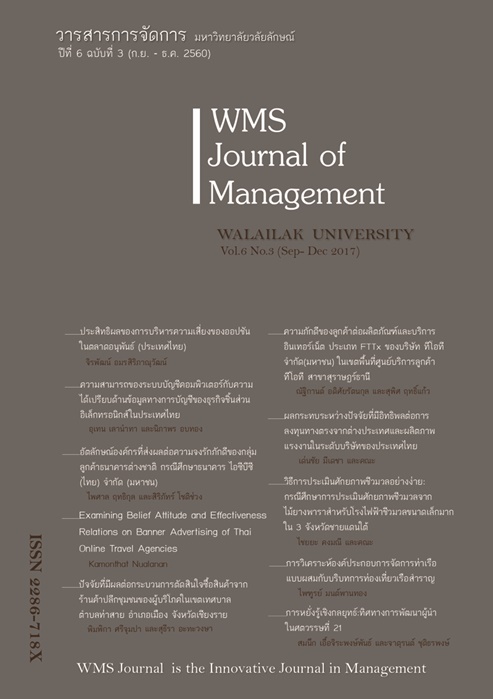Hedging Effectiveness of Options on Thailand Futures Exchange
Main Article Content
Abstract
Article Details
References
Black, F., & Scholes, M. (1973). The pricing of options and corporate liabilities. The Journal of Political Economy, 81(3), 637-654.
Boyle, P. P., & Emanuel, D. (1980). Discretely adjusted option hedges. Journal of Financial Economics, 8(3), 259-282.
Corrado, C. J., & Su, T. (1996). Skewness and kurtosis in S&P 500 index returns implied by option prices. Journal of Financial Research, 19(2), 175-192.
Duan, J. C. (1995). The GARCH option pricing model. Mathematical Finance, 5(1), 13- 32.
Hodges, SD. & Neuberger, A. (1989). Optimal Replication of Contingent Claims under Transaction Costs. The Review of Futures Markets, 8(2), 222-239.
Hull, J., & White, A. (1987). The pricing of options on assets with stochastic volatilities. The Journal of Finance, 42(2), 281-300.
Jarrow, R., & Rudd, A. (1982). Approximate option valuation for arbitrary stochastic processes. Journal of Financial Economics, 10(3), 347-369.
Kiploks, J., & Lazdins, J. (2001). Hedging Effectiveness of Index Options in Sweden. M.Sc. Thesis, Stockholm School of Economics.
Leland, H. E. (1985). Option pricing and replication with transactions costs. The Journal of Finance, 40(5), 1283-1301.
Macbeth, J. D., & Merville, L. J. (1979). An Empirical Examination of the Black‐Scholes Call Option Pricing Model. The Journal of Finance, 34(5), 1173-1186.
Mastinsek, M. (2012). Charm-Adjusted Delta and Delta Gamma Hedging. The Journal of Derivatives, 19(3), 69-76.
Mohamed, B. (1994). Simulations of transaction costs and optimal rehedging. Applied Mathematical Finance, 1(1), 49-62.
Nilakantan, N. S., & Talwar, S. (2014). Discrete Delta-hedging: Indian Market. SCMS Journal of Indian Management, 11(4), 5-17.
Rubinstein, M. (1985). Nonparametric tests of alternative option pricing models using all reported trades and quotes on the 30 most active CBOE option classes from August 23, 1976 through August 31, 1978. The Journal of Finance, 40(2), 455-480.
Wattanatorn, W. (2014). Beyond Black-Scholes: The Stochastic Volatility Option Pricing Model and Empirical Evidence from Thailand.
Wilmott, P., Hoggard, T., & Whalley, A. E. (1994). Hedging Option Portfolios in the Presence of Transaction Costs. Advances in Futures and Options Research, 7, 21-35.
Wilmott, P. (1994). Discrete Charms. Risk Magazine, 7(3), 48-51.
Wilmott, P. (2006). Paul Wilmott on Quantitative Finance. New York: Wiley.
Vähämaa, S. (2003). Skewness and kurtosis adjusted Black- Scholes model: A note on hedging performance. Finance Letters, 1(5), 6-12


